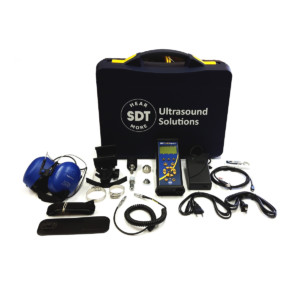Using Acoustic Lubrication Techniques to Provide the Right Amount of Grease at The Right Time
 Every Thursday a mechanic grabs the grease gun and proceeds perform a lube route. Throughout the route, the mechanic pushes the grease gun onto the zerk and pumps grease into the bearing housing. Below the housing, there is a trail of grease leading to a small pile of old grease. The mechanic proceeds to the next machine and attempts to lubricate a bearing. However, no matter how hard he tries to pump the grease gun, the bearing will not take any grease. After a while, he moves on to the next bearing. This last bearing accepts the grease, but the machine has not run in the past 3 months. Does this lube route sound familiar?
Every Thursday a mechanic grabs the grease gun and proceeds perform a lube route. Throughout the route, the mechanic pushes the grease gun onto the zerk and pumps grease into the bearing housing. Below the housing, there is a trail of grease leading to a small pile of old grease. The mechanic proceeds to the next machine and attempts to lubricate a bearing. However, no matter how hard he tries to pump the grease gun, the bearing will not take any grease. After a while, he moves on to the next bearing. This last bearing accepts the grease, but the machine has not run in the past 3 months. Does this lube route sound familiar?
This is typical, and the route is less than effective. In fact, the lube route is probably causing as many issues as it is preventing. Why is this you may ask? Well, over lubricating is just as harmful as under lubricating, and for the bearing that did not take any grease, is it because the line is plugged, or is the line damaged, or is the bearing packed with so many different lubricants, that it has chemically broken down and is now just clay?
But if over lubrication is just as bad as under lubrication, how much grease is required for each lube point? Well, that depends on the bearing size and type, the orientation of the bearing, the speed of the bearing, environmental conditions, running time, etc. There are some complex equations that can be used to determine the optimum amount of lubricant and frequency of lubrication. But this is still not an exact science. There are many variables at play. So, what is the best way to lubricate bearings? Up until recently, that was the best way…
Introducing Acoustic Lubrication
To understand acoustic lubrication, you must first understand how bearings work. There is a rolling element (with a cage), which glides along an inner and outer race. The rolling element should always be gliding along a thin film of lubricant to reduce friction (friction can never be eliminated). When we add lubricate, it is to replace the thin film of lubricant which has degraded.
Depending on the level of lubricant in the bearing, the rolling elements will generate friction, which generates acoustic energy. As the lubricant degrades, the acoustic energy increases, providing a quantifiable method for determining the level of lubricant in the bearing. This is how the mechanic or lube tech can determine if a bearing needs lubrication, is lubricated correctly or over lubricated.
How Does Acoustic Lubrication Work?
To setup an acoustic lubrication program, one must first go back to the theoretical formula to determine the optimum level of grease and frequency. Also, the baseline readings of bearings should be captured. This will then be added to the specialized software which can be downloaded to the acoustic lubrication tool in a route.
Based on the baseline reading of the bearing (in dBuV), and the change of dBuV, the mechanic can determine the status of the bearing;
- An increase of 8dBuV calls for grease
- An increase of 16dBuV is a warning that the bearing has started to fail
- An increase of 24dBuV indicates the bearing is about to fail
If the mechanic decides to add grease, grease is added in half shot intervals, with a 30-60 second pause between shots to allow the grease to disperse in the bearing and the dBuV reading to stabilize. If the acoustic energy did not go down, then the mechanic can add another half shot of grease. If the dBuV starts to increase, then that is an indication that the bearing is being over lubricated. The goal is to have the bearing return to its baseline value.
So not only does acoustic lubrication, ensure the right amount of grease is added to the bearing, it also provides a means of condition monitoring the bearings in the plant. This greatly expands the reach of a traditional CBM program.
Benefits to an Acoustic Lubrication Program
There are numerous benefits to an Acoustic Lubrication program, which is first and foremost improved reliability. But there are others;
- Reduction in lubricant consumption
- Decreased lubrication related failures
- Improved monitoring of assets
- Increased number of assets monitored
- Reduced spare parts stocking (due to less unexpected failures and improved monitoring of assets)
- Reduction in time spent on lube related activities
- Reduction in energy consumption
These benefits are in addition to the improved confidence and morale of the mechanics, who now have the ability to truly understand the condition of the assets they are lubricating.
Getting Started with Acoustic Lubrication
To start with acoustic lubrication, you need the right equipment. It does not have to be expensive, take, for example, SDT’s LUBExpert. It tracks the amount of grease delivered to each bearing and alerts the user if the quantity of grease will exceed the maximum quantity. The software will also allow for trending and report on the bearing conditions. Also, if you already have an SDT270, it can be upgraded to include all of the functionality from the LUBExpert.
Once you have the right equipment, the right training is required. Without training, the program will not yield the benefits expected. SDT offers numerous courses, depending on the organization’s needs;
- 1-day lube tech course
- 2-1/2 day level 1 ultrasound certification
- 2-1/2 day level 2 ultrasound certification
Also, Eruditio, LLC and SDT Ultrasound can provide on-site implementation support to get your acoustic lubrication program off on the right foot.
So, what is stopping your organization, from adopting acoustic lubrication? SDT Ultrasound has some great tools and resources for those interested in adopting this approach to lubrication. You can find out more about the tools, training, and support by contacting [email protected].
Remember, to find success; you must first solve the problem, then achieve the implementation of the solution, and finally sustain winning results.
I’m James Kovacevic
Eruditio, LLC
Where Education Meets Application
Follow @EruditioLLC
References;
[/fusion_builder_column][/fusion_builder_row][/fusion_builder_container]
